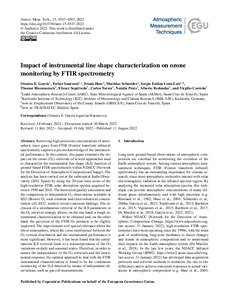Por favor, use este identificador para citar o enlazar este ítem:
http://hdl.handle.net/20.500.11765/14204
Impact of instrumental line shape characterization on ozone monitoring by FTIR spectrometry
Registro completo de metadatos
| Campo DC | Valor | Lengua/Idioma |
|---|---|---|
| dc.contributor.author | García Rodríguez, Omaira Elena | es_ES |
| dc.contributor.author | Sanromá, Esther | es_ES |
| dc.contributor.author | Hase, Frank | es_ES |
| dc.contributor.author | Schneider, Matthias | es_ES |
| dc.contributor.author | León-Luis, Sergio Fabián | es_ES |
| dc.contributor.author | Blumenstock, Thomas | es_ES |
| dc.contributor.author | Sepúlveda Hernández, Eliezer | es_ES |
| dc.contributor.author | Torres, Carlos | es_ES |
| dc.contributor.author | Prats Porta, Natalia | es_ES |
| dc.contributor.author | Redondas, Alberto | es_ES |
| dc.contributor.author | Carreño Corbella, Virgilio | es_ES |
| dc.date.accessioned | 2022-12-07T08:44:42Z | - |
| dc.date.available | 2022-12-07T08:44:42Z | - |
| dc.date.issued | 2022 | - |
| dc.identifier.citation | Atmospheric Measurement Techniques. 2022, 15, 4547–4567 | es_ES |
| dc.identifier.issn | 1867-1381 | - |
| dc.identifier.issn | 1867-8548 | - |
| dc.identifier.uri | http://hdl.handle.net/20.500.11765/14204 | - |
| dc.description.abstract | Retrieving high-precision concentrations of atmospheric trace gases from FTIR (Fourier transform infrared) spectrometry requires a precise knowledge of the instrumental performance. In this context, this paper examines the impact on the ozone (O3) retrievals of several approaches used to characterize the instrumental line shape (ILS) function of ground-based FTIR spectrometers within NDACC (Network for the Detection of Atmospheric Composition Change). The analysis has been carried out at the subtropical Izaña Observatory (IZO, Spain) by using the 20-year time series of the high-resolution FTIR solar absorption spectra acquired between 1999 and 2018. The theoretical quality assessment and the comparison to independent O3 observations available at IZO (Brewer O3 total columns and electrochemical concentration cell, ECC, sondes) reveal consistent findings. The inclusion of a simultaneous retrieval of the ILS parameters in the O3 retrieval strategy allows, on the one hand, a rough instrumental characterization to be obtained and, on the other hand, the precision of the FTIR O3 products to be slightly improved. | es_ES |
| dc.description.sponsorship | The Izaña FTIR station has been supported by the German Bundesministerium für Wirtschaft und Energie (BMWi) via the DLR under grant no. 50EE1711A and by the Helmholtz Association via the research programme ATMO. In addition, this research was funded by the European Research Council under FP7/(2007–2013)/ERC grant agreement no. 256961 (project MUSICA), by the Deutsche Forschungsgemeinschaft for the project MOTIV (Geschäftszeichen SCHN 1126/2-1), the Ministerio de Economía y Competitividad of Spain through the projects CGL2012-37505 (project NOVIA) and CGL2016-80688-P (project INMENSE), and EUMETSAT under its fellowship programme (project VALIASI). | es_ES |
| dc.language.iso | eng | es_ES |
| dc.publisher | European Geosciences Union | es_ES |
| dc.publisher | Copernicus Publications | es_ES |
| dc.rights | Licencia CC: Reconocimiento CC BY | es_ES |
| dc.subject | FTIR spectrometry | es_ES |
| dc.subject | Ozone monitoring | es_ES |
| dc.subject | Atmospheric trace gase | es_ES |
| dc.title | Impact of instrumental line shape characterization on ozone monitoring by FTIR spectrometry | es_ES |
| dc.type | info:eu-repo/semantics/article | es_ES |
| dc.relation.publisherversion | https://doi.org/10.5194/amt-15-4547-2022 | es_ES |
| dc.rights.accessRights | info:eu-repo/semantics/openAccess | es_ES |
| Colecciones: | Artículos científicos 2019-2022 | |
Ficheros en este ítem:
| Fichero | Descripción | Tamaño | Formato | ||
|---|---|---|---|---|---|
| AMT_Garcia_2022.pdf | 6,21 MB | Adobe PDF |  Visualizar/Abrir |
Los ítems de Arcimis están protegidos por una Licencia Creative Commons, salvo que se indique lo contrario.





